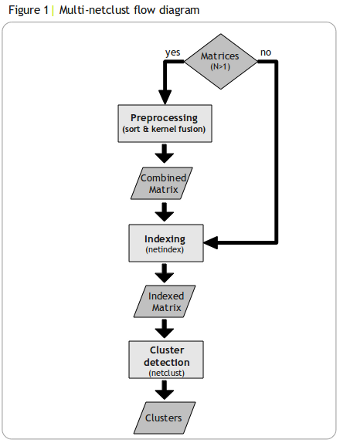
| Graph | N | E | C | CN | CE | File size |
|---|---|---|---|---|---|---|
| T1 | 10,000 | 9,999 | 1 | 10,000 | 9,999 | 116K |
| T2 | 100,000 | 99,990 | 10 | 10,000 | 9,999 | 1.4M |
| T3 | 1,000,000 | 999,900 | 100 | 10,000 | 9,999 | 16M |
| T4 | 10,000,000 | 9,999,000 | 1,000 | 10,000 | 9,999 | 170M |
| C1 | 1,000 | 49,500 | 10 | 100 | 4,950 | 474K |
| C2 | 10,000 | 495,000 | 100 | 100 | 4,950 | 5.6M |
| C3 | 100,000 | 4,950,000 | 1,000 | 100 | 4,950 | 66M |
| RN | 79,083 | 100,000 | 1,441 | NA | NA | 1.4M |
| B1 | 178,228 | 2,745,123 | 35,397 | NA | NA | 61M |
| B2 | 826,554 | 166,445,591 | 33,953 | NA | NA | 4.6G |
| B3 | 2,713,908 | 781,328,458 | 41,072 | NA | NA | 21G |
| N - total number of nodes, E - total number of edges, C - number of components, CN - number of nodes per component, CE - number of edges per component, NA - not applicable as the size of components varies. | ||||||
| Abbr. | Software | Source code | Ref. |
|---|---|---|---|
| NET | netclust (1.0) | C | |
| BCL | BLASTClust, NCBI-BLAST package (2.2.18) | C | [1] |
| CLM | clmclose, MCL package (1.006) | C | [2] |
| Software | Graphs | ||||||||||
|---|---|---|---|---|---|---|---|---|---|---|---|
| T1 | T2 | T3 | T4 | C1 | C2 | C3 | RN | B1 | B2 | B3 | |
| NET | 0.3s 0.5M |
0.6s 4M |
4.7s 38.3M |
1m 12s 381.7M |
0.5s 0.3M |
1.5s 0.5M |
15.1s 4M |
0.8s 3.3M |
0.5sa 7.7M |
2m 13sa 32.3M |
4m 47sa 104.6MB |
| BCL | NA | NA | NA | NA | NA | NA | NA | NA | 1m 20sa 17.4M |
3m 42sa 39.7M |
17m 40sa 152M |
| CLM | 2.8s 3.8M |
23.2s 12.7M |
3m 47s 115.7M |
(32m 29s) (1G) |
0.6s 2.7M |
3.9s 9.2M |
39s 81.6M |
1m 31s 11.4M |
26.8s 40.5M |
(>3G)c | (>3G)c |
| Run-times given in seconds (s), minutes (m) or hours (h), and memory-usages given in megabytes (M) or gigabytes (G). NA - not applicable as BLASTClust can only handle BLAST similarity networks, results in parentheses '()' were obtained using a dedicated 64-bit computer with 32G RAM, arun-time obtained from precomputed and parsed/indexed BLAST similarity data, brun-time not determined due to the memory overflow, crun-time not determined due to premature termination of the matrix loading routine. | |||||||||||
| N | Networks | Run-time |
|---|---|---|
| 2 | T4 + T4 | 5m 27s |
| 2 | T4 x T4 | 6m 30s |
| 4 | T4 + T4 + T4 + T4 | 9m 10s |
| 4 | T4 x T4 x T4 x T4 | 10m 52s |
| 8 | T4 + T4 + T4 + T4 + T4 + T4 + T4 + T4 | 16m 26s |
| 8 | T4 x T4 x T4 x T4 x T4 x T4 x T4 x T4 | 18m 50s |
| Symbols 'x' and '+' refer to the product and sum aggregation rules, respectively. | ||